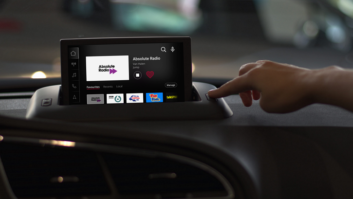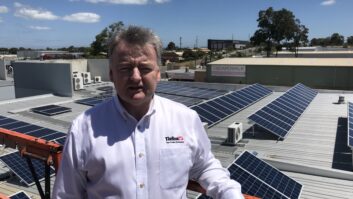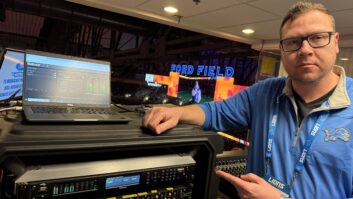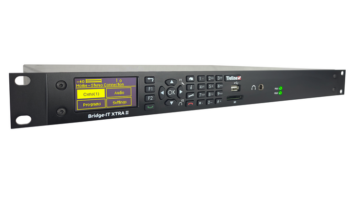Remotes are a fact of life in radio, and we have more options than ever. Let’s start with the lowest quality, a cell phone; in the typical spectrum of remote choices, we then move up to a regular phone line (POTS), single-line frequency extenders, a Marti system, POTS codecs and ISDN. In general, better sound quality usually equals less portability, higher costs and more setup/prep. Just getting a regular POTS line installed can run into the hundreds of dollars.
Luckily for us, codec manufacturers are now up to third-generation devices and some have “stream over GSM” systems available.
The major issue is one of bandwidth. The maximum present U.S. cellular data rate is 6.8 to 9.6 kbps. Anyone who has tried to listen to an 8 kbps stream knows how poor it sounds. Tieline is addressing this niche with its G3 series of remote codecs. The company has developed a custom algorithm that it says can give up to 7 kHz audio at rates as low as 9.6 kbps.
Those still using standard cell phones for remotes know how inconsistent the quality is. This new system can give you a consistent 16 kbps MP3 stream from your remote.
New approach
I serve as chief engineer for WZIP(FM), a student-run station at the University of Akron on 88.1 MHz running 7.5 kW at 800 feet. We operate the station as a professional broadcast training program. We use ENCO automation, Harris AirWave boards, Aphex processing, Harris Z Series transmitter and CD Link STL.
Over the past 25 years I’ve tried many phone remote systems for our sports broadcasts, all of which had to be run by students with minimal training. We went from an old Zercom Maxi-tel system to single-line frequency extenders, then on to three-line extenders and finally second-generation POTS codecs. Every step was an upgrade in sound quality and complexity.
After some issues with dropped links and inability to get POTS lines in some venues, we decided to try a cellular approach. After extensive research I purchased the Tieline i-Mix G3/TLM-600 for the remote mixer/codec and an older, but still compatible, Patriot for the studio end. Now there is a G3 rack unit available for the studio.
The G3 series share some common elements; they have a large rotary menu selection knob, four-line LCD display, input level, headphone level and balance, channel on/off buttons, a dial pad with extra function buttons and a bank of four user-programmable softkeys. Units also feature a four-pin XLR for the 12 V DC power supply input, using an inline supply with a standard IEC power cord. There are two battery power options available for the field units that can give you up to 3.5 hours run time, and a car lighter adapter.
The plug count on the five-channel TLM-600 is impressive. There also are mic/line inputs with switchable phantom power on XLR plugs; two XLR program outs; standard 1/4-inch headphone jacks; RCA aux in and out; Phoenix plug control in/out; and RJ-11 phone line jacks. A set of RS-232, USB and LAN plugs for configuration/control are included, as are IP streaming applications.
On the side is a slot for the optional plug-in modules ($895 each) for GSM cellular, ISDN or a second POTS module for dual mono/stereo broadcasts. The modules slide in and are locked in place with screws.
Units come with a software package called the Toolbox. With this program you can connect to the unit and setup functions, defaults, softkey settings, phonebook entries, audio levels and audio matrix routing; and you can take remote control of all functions. This is a great addition, as it allows you to load up to 98 profiles into the system, which you can use to switch from GSM to POTS, for example.
The Toolbox also allows software updates to be loaded. The i-Mix is really a codec/phone interface with a small digital mixing board added on.
Easy setup, control
(click thumbnail)Fig. 1 Tieline i-Mix G3/TLM-600
When we received our G3 i-Mix and the older Patriot unit, the cellular modules were not available yet, so we just used them in the POTS mode for our first few games. The sports team only needed 15 minutes of training to use them, with minimal calls to my cell phone. We were impressed with the sound quality and robustness of the calls. In locations that had given us trouble with our older codecs, we had no drops at all.
PRODUCT CAPSULETHUMBS UP:
Cellular for remotes; no landlines required
Flexible operation
Profile/preset switching
Intelligent Gain Control is a game-saver
Good to great sound in all modes
THUMBS DOWN:
U.S. GSM limitations
GSM SIMM slot a little larger than the card
PRICE: $4,995
CONTACT: Tieline Technology in Indianapolis at (317) 845-8000 or visit www.tieline.com
The announcers loved the easy setup and control. One feature I loved is the digital Intelligent Gain Control, which lowers the input level automatically if the signal is too hot, and includes a peak limiter. No more digital clipping when the games get exciting.
Another feature I like is the alarm buzzer. You can assign one of the softkeys to a “piezo alarm” and when you press it, the other end gets a buzzing alarm – just to get someone’s attention of course.
After getting the GSM module in, we set up our cell account with T-Mobile. The GSM module is an entire cell phone, so all you do is put your SIMM card in the included holder, slide it in the slot and attach the antenna. A portion of the manual and two extra data sheets are devoted to describing how to order your cell service with the Circuit Switched Data you need. You can’t just put your regular cell SIMM card in and expect it to go.
One thing to keep in mind. With either T-Mobile or Cingular (the only two providers recommended so far) you will have more than one phone number when you’re done; I have three.
Once it was finally up and running, we tried it in a high school gym but couldn’t get cellular service – too much steel in the roof and walls. The following week we tried it in a different gym and it worked well. There was one drop but overall the sound quality was much better than using a cell phone with one of the dual mic adapter (flip) boxes we tried earlier.
Since that time we received a new cellular antenna from Tieline that has a 3 db gain over the older unit, and updated codec/control software. I hooked up the updated system using a Commander G3 TLF-300, loaned for testing, and gave it a go. It worked everywhere I tried, and even ran several feet from an AM/FM transmitter room with no drops.
The GSM can have up to a half-second delay, some of which is from your cellular provider. I did some testing on the G3 system and found the GSM quality to be almost equal to a 24 kbps mono MP3 stream. It sounded close at 20 kbps but the treble was still better with the GSM.
The MP3 encoder I use has an 11 kHz sample rate for the 6 kbps-20 kbps encoded streams; I needed to have a 22 khz sample rate to get the high end to compare with the GSM codec. I then recorded some music, and my voice direct and GSM-coded into Cool Edit Pro to do some frequency analysis, and found the response was good out past 7 kHz in my setup. That is why I had to get above the 11 kHz sample rate – that extra 1/2 octave makes a difference in the perceived voice quality. Some screen shots of the frequency response from my tests are included on this page.
The GSM codec works well. There is the expected MPEG-style “high-end swishing,” but much less than you would expect at these low bitrates. All in all it is a major step up over any other wireless system I have heard. I will still try to get a POTS line to use in most locations, but now I have a wireless option. The Tieline i-Mix G3/TLM-600 retails for $4995.








